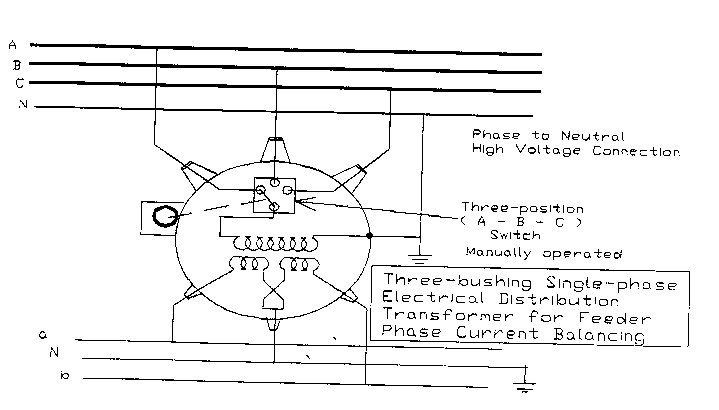Some of the information on this Web page has been provided by external sources. The Government of Canada is not responsible for the accuracy, reliability or currency of the information supplied by external sources. Users wishing to rely upon this information should consult directly with the source of the information. Content provided by external sources is not subject to official languages, privacy and accessibility requirements.
Any discrepancies in the text and image of the Claims and Abstract are due to differing posting times. Text of the Claims and Abstract are posted:
| (12) Patent Application: | (11) CA 2086650 |
|---|---|
| (54) English Title: | MULTI-BUSHING SINGLE-PHASE ELECTRIC DISTRIBUTION TRANSFORMER FOR FEEDER PHASE CURRENT BALANCING |
| (54) French Title: | TRANSFORMATEUR DE DISTRIBUTION MONOPHASE A TRAVERSEES MULTIPLES A COURANT DE PHASE D'ALIMENTATION EQUILIBRE |
| Status: | Deemed Abandoned and Beyond the Period of Reinstatement - Pending Response to Notice of Disregarded Communication |
| (51) International Patent Classification (IPC): |
|
|---|---|
| (72) Inventors : |
|
| (73) Owners : |
|
| (71) Applicants : | |
| (74) Agent: | |
| (74) Associate agent: | |
| (45) Issued: | |
| (22) Filed Date: | 1993-01-04 |
| (41) Open to Public Inspection: | 1994-07-05 |
| Examination requested: | 1993-01-04 |
| Availability of licence: | N/A |
| Dedicated to the Public: | N/A |
| (25) Language of filing: | English |
| Patent Cooperation Treaty (PCT): | No |
|---|
| (30) Application Priority Data: | None |
|---|
MULTI-BUSHING SINGLE-PHASE ELECTRIC DISTRIBUTION TRANSFORMER
FOR FEEDER PHASE CURRENT BALANCING
Abstract
In three-phase electric power distribution systems, kilowatt-hour
conductor losses can be reduced by keeping the current flows in all
three-phases as equal to each other as possible.
A secondary benefit of phase balancing is an improved voltage
regulation.
At present, phase balancing can be achieved by taking the phase-
current measurements, detecting a feeder with a significant current
unbalance,identifying a single-phase transformer connected to the
highest loaded phase, and then manually reconnecting it to the
lowest loaded phase. The operation involves time consuming
activities in engineering, and the deployment of personnel,
equipment and resources for its execution, plus loss of revenue
and/or inconveniences caused by an outage of several minutes
duration.
In this invention, a single-phase transformer is provided with:
three high-voltage bushings, and an internal high voltage side
three-position load-break switch. All the necessary connections are
already in place, and through the operation of the switch the
transformer load is transferred from the highest loaded phase to
the lowest loaded phase; thereby tending to an equilibrium of
circuit phase currents and therefore reducing the system losses.
The invention makes the phase-balancing process fast, easy,
convenient, safe, and economical.
Note: Claims are shown in the official language in which they were submitted.
Note: Descriptions are shown in the official language in which they were submitted.

2024-08-01:As part of the Next Generation Patents (NGP) transition, the Canadian Patents Database (CPD) now contains a more detailed Event History, which replicates the Event Log of our new back-office solution.
Please note that "Inactive:" events refers to events no longer in use in our new back-office solution.
For a clearer understanding of the status of the application/patent presented on this page, the site Disclaimer , as well as the definitions for Patent , Event History , Maintenance Fee and Payment History should be consulted.
| Description | Date |
|---|---|
| Inactive: IPC from MCD | 2006-03-11 |
| Time Limit for Reversal Expired | 1995-07-04 |
| Application Not Reinstated by Deadline | 1995-07-04 |
| Inactive: Adhoc Request Documented | 1995-01-04 |
| Deemed Abandoned - Failure to Respond to Maintenance Fee Notice | 1995-01-04 |
| Application Published (Open to Public Inspection) | 1994-07-05 |
| All Requirements for Examination Determined Compliant | 1993-01-04 |
| Request for Examination Requirements Determined Compliant | 1993-01-04 |
| Abandonment Date | Reason | Reinstatement Date |
|---|---|---|
| 1995-01-04 |
Note: Records showing the ownership history in alphabetical order.
| Current Owners on Record |
|---|
| LUIS FERNANDO LLANO |
| Past Owners on Record |
|---|
| None |